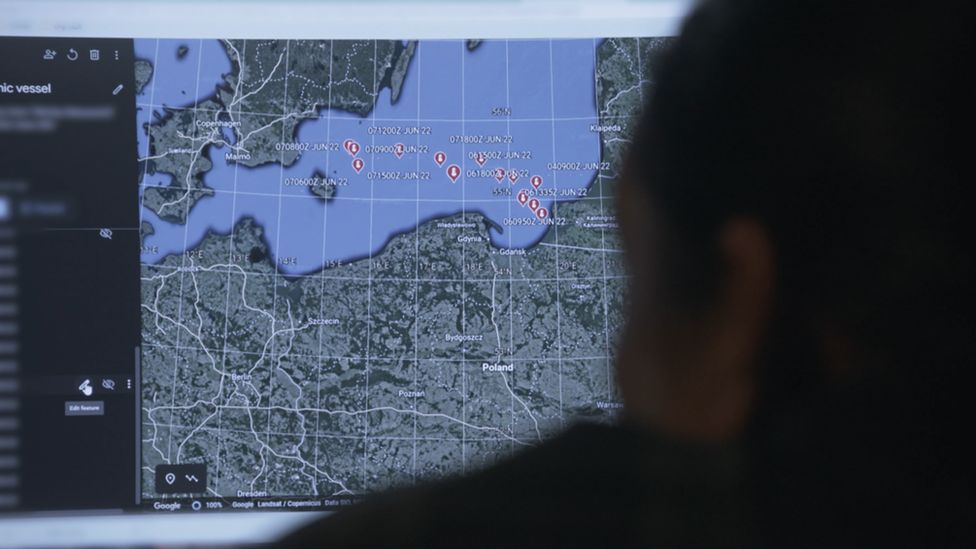ARTICLE AD BOX
 Image source, Putin's Shadow War
Image source, Putin's Shadow War
A former UK naval intelligence officer says he used open-source information to track the ships
By Gordon Corera
Security correspondent, BBC News
Russian ships able to perform underwater operations were present near to where explosions later took place on the Nord Stream pipelines, according to an investigative documentary.
The vessels were reportedly located using intercepted Russian navy communications.
Underwater explosions last September knocked the two Nord Stream pipelines - built to carry gas from Russia to Europe - out of action.
The cause of the blasts is unclear.
In the immediate aftermath, some in the West pointed the finger at Russia, while Moscow blamed Western countries, including the UK.
More recently, there were reports that intelligence pointed towards pro-Ukrainian operatives, although not the Ukrainian government itself.
Formal investigations are still taking place in countries close to the blast site. So far, these nations have only said they believe the explosions were the result of sabotage rather than any kind of accident.
But the latest programme in the TV documentary series Putin's Shadow War and accompanying English language podcast Cold Front provides one possible lead pointing towards Russia's involvement.
The series by Denmark's DR, Norway's NRK, Sweden's SVT, and Finland's Yle broadcasters revealed last month that Russian vessels appeared to be mapping out wind farms in the North Sea, including off the UK coast.
Now, the latest episode focuses on what they say are suspicious ship movements in the run-up to the Nord Stream blasts.
Image source, Danish Defence
Image caption,Just five days before the blasts, Russian tug SB-123 reportedly arrived at the site and stayed for an entire evening and night
The ships are believed to include the Russian naval research vessel Sibiryakov, the tugboat SB-123, and a third ship from the Russian naval fleet that the media outlets have not been able to identify by name.
These were so-called "ghost-ships", which had their transmitters turned off. The broadcasters, however, say they were able to track their movements, using intercepted radio communications the vessels sent to Russian naval bases between June and September 2022.
These movements were tracked by a former British naval intelligence officer, who worked on interception of the Russian Baltic Fleet until he retired in 2018. That person - who remains anonymous in the documentary - says he used open-source information and radio communications to carry out his research.
These ships are said to have been in the vicinity of an explosion site for several hours and, in one case, for almost a full day.
One of the vessels, the Sibiryakov, is believed to be capable of underwater surveillance and mapping as well as launching a small underwater vehicle.
The former Royal Naval intelligence officer says it took an unusual navigational track in June, around the place where the pipeline would later blow up, and changed its communications pattern to a secret receiver.
Another unnamed vessel was also present in that area the previous week in June.
And a third vessel, the naval tugboat the SB-123, is said to have arrived just five days before the September explosions. The radio communication suggests that it stayed there for the entire evening and night before sailing back towards Russia.
Underwater drone footage of the damage to the Nord Stream pipeline
Satellite imagery examined by the broadcasters is said to support the claims about the unusual routes, and other reports in Germany had claimed it was in the area on 21-22 September.
This vessel can be used to support and rescue submarines and has the ability to carry out operations on the seabed, according to experts interviewed by the broadcasters.
Last week it emerged that the Danish military had taken 26 photographs of another Russian navy vessel specialising in submarine operations near the site of the blasts.
A Danish newspaper said the submarine rescue ship SS-750 was photographed four days before the explosions close by. That vessel can carry a mini submarine.
The documentary does not say there is conclusive proof of what the vessels were up to or that Russia was behind the blast. But it raises questions about the unusual nature of the activity.
Russia has consistently denied any involvement in the blasts.

 1 year ago
15
1 year ago
15








 English (US)
English (US)